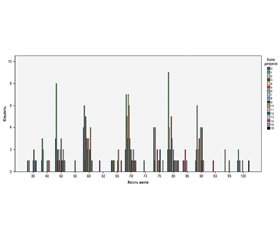Журнал «» Том 18, №1, 2025
Вернуться к номеру
Вплив гендерних особливостей, поліпрагмазії, тривоги і депресії на прихильність до лікування у пацієнтів з ішемічною хворобою серця і коморбідними станами
Авторы: Білоусова Н.А., Сіренко Ю.М., Лучинська Ю.О., Яковенко Л.І., Долженко М.М.
Національний університет охорони здоров’я України імені П.Л. Шупика, м. Київ, Україна
Рубрики: Кардиология
Разделы: Клинические исследования
Версия для печати
Актуальність. Відомо, що соціальні наслідки недотримання прихильності до лікування є вражаючими: недотримання фармакотерапії асоціюється зі 125 000 смертей на рік у США та 194 500 у Європі. З огляду на швидке зростання глобальної популяції з ішемічною хворобою серця (ІХС) і нові клінічні та економічні переваги прихильності, розв’язання проблеми недотримання призначеної фармакотерапії є пріоритетом сьогодення. Мета: ретроспективно дослідити можливий вплив гендерних ознак, поліпрагмазії у лікарських призначеннях, якості життя, станів тривоги і депресії на модель прихильності до лікування, що дозволить поліпшити інструмент скринінгу для виявлення пацієнтів групи високого кардіального ризику. Матеріали та методи. У дослідженні використовувались медичні дані української когорти пацієнтів, які брали участь у спостережному дослідженні EUROASPIRE V у період з 2017 по 2018 рік (госпітальна та амбулаторна лінії). Результати. Для гендерних ознак (B = –0,794; Exp(B) = 0,452 (менше за 1); p = 0,044) достовірно підтверджено зменшення прихильності до лікування у жінок на 54,8 % порівняно з чоловіками, що може бути корисним при розробці програм, спрямованих на підвищення прихильності до лікування залежно від гендерних ознак. Розрахунки кількості призначених лікарських засобів під час першого візиту (B = 0,071, Exp(B) = 1,073, p = 0,594) демонструють відсутність достовірного зв’язку між кількістю призначених лікарських засобів під час першого візиту та рівнем прихильності до лікування у хворих на ІХС з коморбідними станами. У групі пацієнтів зі зниженою прихильністю до лікування достовірно більший відсоток мали ознаки тривоги та депресії (р < 0,05) при порівнянні із групою прихильних до лікування. Аналіз кореляції якості життя зі станами депресії та тривоги вказує на дуже слабкий (0,039) і недостовірний (р > 0,05) взаємозв’язок між цими ознаками у хворих на ІХС з коморбідними станами у період спостереження 2017–2018 рр. Висновки. Визначено поширеність поліпрагмазії у фармакотерапії ІХС з коморбідними станами 76,47 % [76,44–76,50; p < 0,05] та використання складної лікарської моделі у фармакотерапії ІХС з коморбідними станами. Достовірно підтверджений негативний вплив кількості призначених лікарських засобів під час другого візиту (B = 0,397, Exp(B) = 1,488, p < 0,05) із прихильністю до лікування, що потребує використання в схемах лікування фіксованих комбінацій та спрощення самих схем лікування. Запропонована модель логістичної регресії: logit (P) = −1,629 − 0,794 × Стать + 0,071 × 1-й візит + 0,397 × 2-й візит — підтверджує теоретичну можливість розглядати цю модель як описову.
Background. It is well established that the social consequences of non-adherence to treatment are significant: failure to adhere to pharmacotherapy is associated with 125,000 deaths annually in the USA and 194,500 in Europe. Given the rapid global increase in coronary heart disease (CHD) prevalence and the emerging clinical and economic benefits of adherence, addressing non-adherence to prescribed pharmacotherapy remains a top healthcare priority. The purpose was to retrospectively examine the potential influence of gender differences, polypharmacy, quality of life, anxiety, and depression on the model of adherence to treatment. The findings aim to enhance screening tools for identifying high-risk cardiac patients. Materials and methods. This study analyzed medical data from the Ukrainian cohort of patients who participated in the EUROASPIRE V observational study (2017–2018) in both hospital and outpatient settings. Results. Gender differences (B = –0.794; Exp(B) = 0.452; p = 0.044) were found to significantly impact treatment adherence, with women demonstrating a 54.8 % lower adherence rate compared to men. This finding suggests the need for gender-specific interventions to improve adherence. Polypharmacy at the first visit (B = 0.071, Exp(B) = 1.073, p = 0.594) did not show a significant association with adherence levels in CHD patients with comorbidities. Anxiety and depression were significantly more prevalent (p < 0.05) in the non-adherent group compared to the adherent one. The correlation between quality of life and anxiety/depression was very weak (0.039) and statistically insignificant (p > 0.05) in CHD patients with comorbidities over the study period (2017–2018). Conclusions. Polypharmacy prevalence in CHD pharmacotherapy was 76.47 % [76.44–76.50; p < 0.05], confirming the complexity of drug regimens used in CHD patients with comorbid conditions. An increased number of prescribed drugs at the second visit (B = 0.397, Exp(B) = 1.488, p < 0.05) negatively impacted adherence, reinforcing the need for fixed-dose combinations and simplified treatment regimens. The proposed logistic regression model, logit (P) = –1.629 – 0.794 × gender + 0.071 × 1st visit + 0.397 × 2nd visit, supports the theoretical validity of considering this model as descriptive.
ішемічна хвороба серця; артеріальна гіпертензія; якість життя; прихильність до лікування; тривога; депресія; поліпрагмазія
coronary heart disease; arterial hypertension; quality of life; treatment adherence; anxiety; depression; polypharmacy

